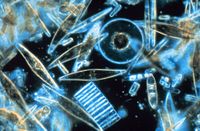
Phylogenetic position and age of Lake Baikal candonids (Crustacea, Ostracoda) inferred from multigene sequence analyzes and molecular dating
Sign Up to like & getrecommendations! Published in 2017 at "Ecology and Evolution"
DOI: 10.1002/ece3.3159
Abstract: Abstract With 104 endemic species family Candonidae is one of the most diverse crustacean groups in Lake Baikal, yet their phylogenetic relationships and position in the family have not been addressed so far. Here, we… read more here.
Keywords: phylogenetic position; position; lake baikal; baikal ... See more keywords

Lake Baikal's response to remote earthquakes : lake-level fluctuations and near-bottom water layer temperature change
Sign Up to like & getrecommendations! Published in 2018 at "Marine and Petroleum Geology"
DOI: 10.1016/j.marpetgeo.2017.10.024
Abstract: Abstract The 2011 Mw9.0 Tohoku earthquake and the 2012 Mw8.6 and 2016 Mw7.8 Sumatra earthquakes caused water level oscillations in Lake Baikal which were recorded by a water pressure tensor transducer with high sampling rate.… read more here.
Keywords: tohoku earthquake; temperature; water; layer ... See more keywords

Current chemical composition of Lake Baikal water
Sign Up to like & getrecommendations! Published in 2017 at "Inland Waters"
DOI: 10.1080/20442041.2017.1329982
Abstract: Abstract Habitats of organisms in Lake Baikal have been comprehensively monitored for many years. In 2010–2015, we conducted 8 research expeditions to study ionic composition of the water and measure concentrations of dissolved oxygen, nutrients,… read more here.
Keywords: water; baikal; lake baikal; composition ... See more keywords

Is a High Abundance of Spring Diatoms in the Photic Zone of Lake Baikal in July 2019 Due to an Upwelling Event?
Sign Up to like & getrecommendations! Published in 2021 at "Diversity"
DOI: 10.3390/d13100504
Abstract: A high abundance of planktonic microalgae is typically thought to be related to their ‘bloom’, that is, to active population growth. Diatom blooms in the photic zone of Lake Baikal generally occur during hydrological spring… read more here.
Keywords: spring; high abundance; baikal; july 2019 ... See more keywords

Metagenomic Analysis of Virioplankton from the Pelagic Zone of Lake Baikal
Sign Up to like & getrecommendations! Published in 2019 at "Viruses"
DOI: 10.3390/v11110991
Abstract: This study describes two viral communities from the world’s oldest lake, Lake Baikal. For the analysis, we chose under-ice and late spring periods of the year as the most productive for Lake Baikal. These periods… read more here.
Keywords: analysis virioplankton; lake baikal; baikal; metagenomic analysis ... See more keywords

Hydroacoustic assessment of Baikal omul (Coregonus migratorius) reserves based on the results of two-year studies in the spring-summer period of 2021 and 2022
Sign Up to like & getrecommendations! Published in 2023 at "Fisheries"
DOI: 10.37663/0131-6184-2023-2-73-79
Abstract: Taking into account the depressive condition of the Baikal omul resource, the decree of the Ministry of Agriculture of the Russian Federation No. 450 dated August 29, 2017 strict restrictions were established on the catch… read more here.
Keywords: baikal omul; baikal; northern baikal; shallow water ... See more keywords

Identification of causes of death of Baikal seal (Pusasibirica Gmelin, 1788)
Sign Up to like & getrecommendations! Published in 2020 at "Turkish Journal of Zoology"
DOI: 10.3906/zoo-1905-18
Abstract: The Baikal seal is the only endemic mammal of Lake Baikal. In late October 2017, 132 dead Baikal seals were found on the shore of the lake. To identify causes of death, postmortem necropsy, virological,… read more here.
Keywords: identification causes; baikal; causes death; baikal seal ... See more keywords